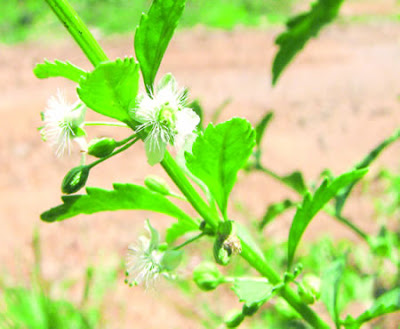 |
| Leaves of Scoparia dulcis |
Certainly, there is no substitute for a balanced healthy diet, but adding certain foods may help those with diabetes keep sugar levels under control.
Beans and non-starchy vegetables such as broccoli, cucumber, and carrots have made headlines as foods that might be able to help reduce the risk of diabetes or help maintain healthy blood sugar levels. However, a healthy diet for diabetes is also porridge made from whole grains and vegetables and herbs such as cabbage, bitter leaf, broccoli, and Scoparia dulcis known with blood sugar lowering effects.
Scoparia dulcis is used as a herbal remedy by diabetics worldwide given its ability to lower blood sugar. Products such as tablets and tea made from this herb are currently available in the international market.
Researchers found incorporating Scoparia dulcis into different porridge, including that made from rice, a common mode of ingesting this herb proven to have anti-hyperglycaemic and anti-hyperlipidaemic effects.
Porridges are more palatable and fulfilling compared to a mere water extract of herbs or tablets and could be ingested as a meal. It is a staple food in much of Africa often made from different grains and food products. It was primarily a savoury dish, with meats, root crops, vegetables and herbs added for flavour.
In a randomised crossover clinical trial published in the 2015 BMC Complementary and Alternative Medicine, researchers found out that an herbal porridge made with Scoparia dulcis ensured a lowering of blood’s sugar and cholesterol levels.
The study involved 35 persons aged between 35 and 70 years with type 2 diabetic patients that were on medication, with mild and moderate diabetes. Those already with complications of diabetes were exempted. They were recruited from the Diabetes clinic of the Family Practice Centre, University of Sri Jayewardenepura, Sri Lanka.
Test group consumed commercially produced SDC for 3 days/week for three months and the control group any other food. The SDC was made from tender leaves of Scoparia dulcis, scraped coconut kernel and red rice [in 25: 15: 10 (w/w/w) ratio]
At the onset and end of each study period, their blood sugar and cholesterol levels were tested. Also, the possibility of its toxicity on body organs was assessed.
They found that porridge made with SDC leaf extract decreased blood sugar levels in type 2 diabetic patients, thus contributing to a reduction of micro-vascular and other fatal complications in diabetics, including death.
Also, the porridge had no effect on cholesterol measurements. Also no toxicity was observed at the dose tested.
Given that rice based herbal porridge is more palatable and fulfilling than a leaf extract or a tablet, they recommended that porridge used for this study would be a better breakfast meal for diabetics due to its medium glycemic index (GI), blood sugar lowering effects and absence of toxicity.
Leaf extracts of Scoparia dulcis, is used as an herbal remedy by diabetics worldwide. Referred to as Roma-fada (Hausa), Aiya (Igbo), Mesen-mesen gogoro (Yoruba), the plant has been used in the management of sickle cell anaemia for over two decades. This plant also called sweet broomweed is also used for chest diseases, cough, conjunctivitis and gonorrhoea.
In Brazil, it has been used for various problems such as haemorrhoids and wounds, while it is used in Nicaragua for anaemia, burns, and headaches.
Previously, researchers have also said that non-starchy vegetables such as broccoli, cucumber, and carrots as well as spices such as cinnamon can also help prevent surges in blood sugar levels while providing essential nutrients.
A 2013 study published in the journal Annals of Family Medicine showed that cinnamon is linked to a significant drop in fasting blood sugar levels. Cinnamon may stimulate insulin secretions from the pancreas.
There’s some evidence that oat, which is also high in soluble fibre, may also help with blood glucose control. Scientists found an increase in fibre, especially cereals, in the diet was linked to a lower risk of developing type 2 diabetes.
A new study shows those with the highest total fibre intake – more than 26g per day – had an 18 per cent lower risk of developing diabetes compared to those eating less than 19g a day. The study was published in Diabetologia, the journal of the European Association for the Study of Diabetes.
Written by Sade Oguntola
(adsbygoogle = window.adsbygoogle || []).push({});

